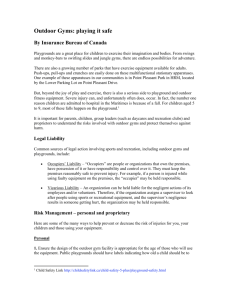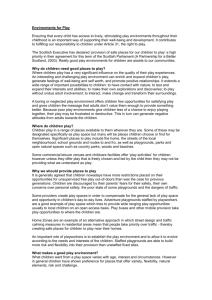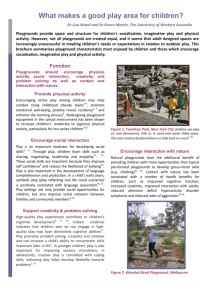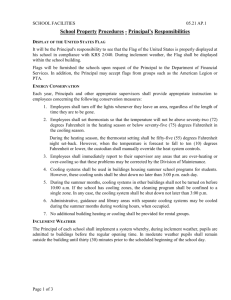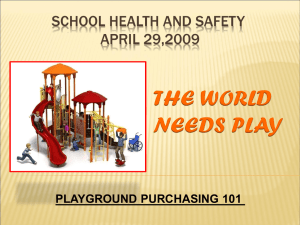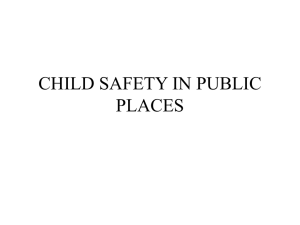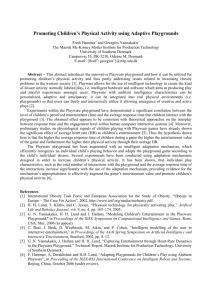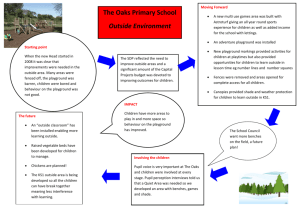What's Wrong with America's Playgrounds and How to Fix Them
advertisement
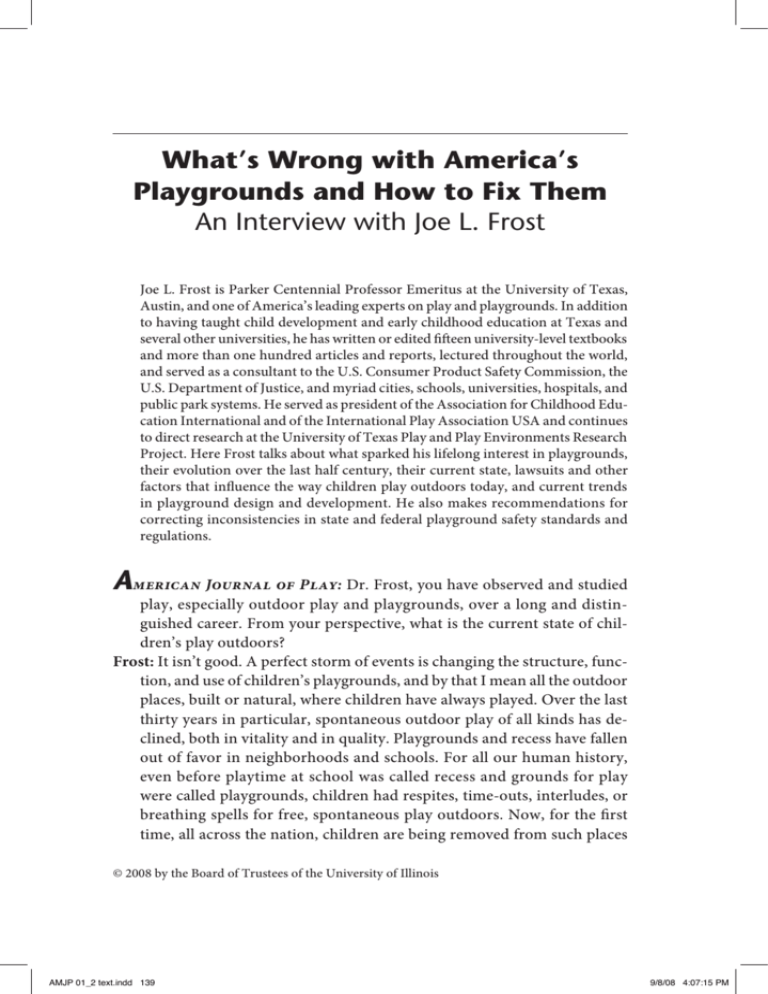
What’s Wrong with America’s Playgrounds and How to Fix Them An Interview with Joe L. Frost Joe L. Frost is Parker Centennial Professor Emeritus at the University of Texas, Austin, and one of America’s leading experts on play and playgrounds. In addition to having taught child development and early childhood education at Texas and several other universities, he has written or edited fifteen university-level textbooks and more than one hundred articles and reports, lectured throughout the world, and served as a consultant to the U.S. Consumer Product Safety Commission, the U.S. Department of Justice, and myriad cities, schools, universities, hospitals, and public park systems. He served as president of the Association for Childhood Education International and of the International Play Association USA and continues to direct research at the University of Texas Play and Play Environments Research Project. Here Frost talks about what sparked his lifelong interest in playgrounds, their evolution over the last half century, their current state, lawsuits and other factors that influence the way children play outdoors today, and current trends in playground design and development. He also makes recommendations for correcting inconsistencies in state and federal playground safety standards and regulations. American Journal of Play: Dr. Frost, you have observed and studied play, especially outdoor play and playgrounds, over a long and distinguished career. From your perspective, what is the current state of children’s play outdoors? Frost: It isn’t good. A perfect storm of events is changing the structure, function, and use of children’s playgrounds, and by that I mean all the outdoor places, built or natural, where children have always played. Over the last thirty years in particular, spontaneous outdoor play of all kinds has declined, both in vitality and in quality. Playgrounds and recess have fallen out of favor in neighborhoods and schools. For all our human history, even before playtime at school was called recess and grounds for play were called playgrounds, children had respites, time-outs, interludes, or breathing spells for free, spontaneous play outdoors. Now, for the first time, all across the nation, children are being removed from such places © 2008 by the Board of Trustees of the University of Illinois AMJP 01_2 text.indd 139 9/8/08 4:07:15 PM 140 A m erican J o u rnal of PLAY • Fa l l 2 0 0 8 and activities, and the consequences for health and development are destructive and profound. AJP: What are some of those consequences? Frost: In general terms, limiting children’s outdoor play harms their cognitive, social, and language development. It limits their physical fitness, hurts their health, and reduces learning and the ability to cope with trauma. Research shows that when children engage in free, spontaneous play outdoors, they adapt more readily to their culture, to society, and to the world. They build fine and gross motor skills. They learn to negotiate and solve problems. They stretch their imagination. They become more flexible in their thinking, and they develop creative and aesthetic appreciation. AJP: We know, of course, that the body of research supporting the value of play is extensive, but what relatively recent studies or reports particularly impress you? Frost: There are, as you say, many studies, but I’ll give you four examples. In 2006, a clinical report by the American Academy of Pediatrics noted all the benefits I just mentioned and, in addition, cited healthy brain growth, development of multiple competencies, and increased leadership skills. A research review by the American Heart Association that same year and a Stanford University study in 2007 both supported the pediatric academy findings and cited the prevention of obesity, high cholesterol, high blood pressure, and heart disease. All of those are factors implicated in shortened life spans. The scientists who did this work concluded that physical education and recess at school and outdoor play at home are essential to healthy child development. If inactivity among children isn’t addressed, the current generation may be the first in American history to have a shorter life span than their parents. In another study published in 2007, researchers supported by the Robert Wood Johnson Foundation looked at more than 11,500 kindergartenthrough-eighth-grade students in 1,000–plus schools and concluded that what happens at recess is just as important as what happens in the classroom when it comes to issues like depression, violence, or obesity. Only 36 percent of America’s children meet doctors’ recommendations for physical activity during the school year, so recess offers us our best chance for meeting these needs. Unfortunately, loss of outdoor play and recess has resulted in a generation of children who have greater need for supervision by adults when they play because they’ve had too few opportunities to learn how to do it on their own. The researchers found children need teachers who AMJP 01_2 text.indd 140 9/8/08 4:07:15 PM Interview with Joe L. Frost 141 are trained to facilitate play, who can introduce traditional games that are now all but forgotten, who can help avoid and resolve conflicts, and who can teach healthy nutrition. At the same time, it’s important that adults responsible for children in school don’t interfere unduly with the children’s rights and needs to engage in the kind of free, creative, spontaneous play from which they learn so much. AJP: What other major areas of research are important to your view of play? Frost: In addition to the developmental values of play, I regard the therapeutic benefits of play as extremely important. Both indoor and outdoor play contribute to a wide range of healing processes. The effects are most evident in children’s hospitals, centers for disturbed children, and places devastated by natural disasters and war. Play carries healing power wherever it is practiced, and these benefits are documented in a significant body of research. I’m also taken with the extensive research into children’s games, into symbolic or imaginative play, and into the brain and play. For example, during the 1990s, biologists, neuroscientists, psychologists, and other scholars learned that play is as important as other basic drives. Advanced tools of brain imaging allowed them unprecedented insights into the role of experience, including play, in human development. Researchers at Baylor College of Medicine concluded that children who don’t play much may have brains 20 to 30 percent smaller than normal for their age. There has also been interesting work suggesting that play deprivation among children can lead to aberrant behavior when they become adults. Stuart Brown, founder of the National Institute for Play, has written about this, as has Bruce D. Perry, who may be best known as coauthor of The Boy Who Was Raised as a Dog. AJP: Where did you play as a child? Frost: I played outdoors, a lot, and it was great. I grew up during the last years of the Great Depression and the early years of World War II on a small farm in the Ouachita Mountains of southwestern Arkansas, and we played in the fields and woods and streams. I also had occasion to play and work in the vacant lots, streets, and junkyards of a small city, where I learned how to sort junk for a junk dealer and how to watch for cops and keep them away from the crap games played by older boys back in the alleys. I also played in our country schoolyard and the woods around it. We had recess morning and afternoon, plus an hour at noontime for bacon, biscuits, and more play. We also played while waiting for our rickety school bus every morning and afternoon, which meant most days we had five play times. AMJP 01_2 text.indd 141 9/8/08 4:07:16 PM 142 A m erican J o u rnal of PLAY • Fa l l 2 0 0 8 AJP: What did you play during those school-related play times? Frost: We didn’t have any playground equipment, just a barren field in front of the school, a stream running behind it, and a tree-covered mountain just beyond it. Looking back, though, this was a truly enviable playground because it afforded great versatility. We improvised games of war, chase, fort and dam building, shinny, dog pile, hot pants, and catapult, and we learned a lot of traditional games, some of them ancient, from the older kids. We made up and changed rules as we went—subject, of course, to argument and physical persuasion. Teachers usually stayed indoors except to watch or stop a fight or explain a game involving both boys and girls. When we played war behind the school, one kid would be stationed near the building to run up the mountain and alert players when the teacher rang the bell. Some of the games were not only spontaneous, they were also brutal, or at least hazardous. In dog pile, a group of boys would walk around the playground looking for a victim, and when they found a good candidate, someone would yell, “Dog pile!” and all the boys would jump on him. When everyone got off, the victim would join the dog pile team in looking for the next unsuspecting fellow. If you were a snitch, or if you didn’t play or fight fair, the other kids dog-piled you over and over until you changed your behavior. Whenever we had a big rain, boys—and girls, too—would dam up the stream behind the school and then let loose a torrent to wash out another group’s dam downstream. This was some of the most intense play I remember. Perhaps it’s what today’s writers have in mind when they talk about deep play, flow, or fully functioning and transcendental play. It seemed that the more creative play was, the greater the interest, and the more fascinating and useful the results. AJP: What was the game of hot pants? It sounds either provocative or dangerous. Frost: Hot pants was one of the few games teachers banned as soon as they learned about it. All the boys would choose up sides, and the players on each side would stand in separate lines, one fellow behind another and so on. Everyone would put a piece of paper in his back pocket, and then someone would set the papers of the first players in each line on fire. They would then run as far as they could before stamping out the fire, and that point would be the starting place for the next player to do the same thing. The team that covered the greatest total distance won. Fortunately, no one was ever seriously hurt during this play. The only recess injury we ever AMJP 01_2 text.indd 142 9/8/08 4:07:16 PM Interview with Joe L. Frost 143 had that required hospital care occurred during a catapult game on the mountain. In this game, older boys would climb a pine sapling, pull the top to the ground, coax a younger boy to hold on while they released it, and tell him to let go when he was about head high. Once one boy didn’t understand the instructions and was shot into space. He suffered a concussion from the landing, the other boys got a whipping from the principal, and that ended our catapult play. AJP: How influential were those early play experiences in shaping your professional career? Is that what led you eventually to study playgrounds? Frost: Those experiences were important, yes. But so was what happened inside the school. I loved books, and as a boy in rural Arkansas, I read everything I could get my hands on, including comic books, loaners from the county library, and free government books and pamphlets I sent for via penny postcards. These two things eventually came together in my research. I expect that doesn’t surprise you, because I know that Strong National Museum of Play regards reading as a form of play and has a wonderful, huge interactive exhibit called Reading Adventureland. My interest in playgrounds stemmed from a childhood of farm chores and several years I spent later on working as a mechanic with Boeing engineers building B-52 bombers. When factory work no longer excited me, I went back to school, earned a teaching certificate, and taught five years at elementary schools in the foothills of the Ozarks and at the University of Arkansas Training School. That, in turn, sparked my interest in further study. I earned a doctorate with concentrations in child development and education at the University of Arkansas, and I also studied during summers at the University of Michigan and University of Maryland. My first published article appeared in the annual proceedings of the Inter-Institutional Seminar in Child Development, which Michigan and several other universities sponsored. Perhaps as a result of my own childhood experiences, I focused on children and poverty, a subject that influenced my teaching and research for several years. After I left Arkansas, I taught for a time in the department of child development at Iowa State University, and then, in 1966, I went to the University of Texas and helped build a graduate program in early childhood education. Not long after I arrived there, I was invited to give a lecture about play and playgrounds to a group of teachers, and when we couldn’t find a good playground model to observe and talk about, we decided to build one. That, in turn, led me to develop courses on play, on play environments, and on play and child development. The playground emphasis evolved from there. AMJP 01_2 text.indd 143 9/8/08 4:07:16 PM 144 A m erican J o u rnal of PLAY • Fa l l 2 0 0 8 AJP: What distinguishes a playground from a place where children play, aside from one being constructed specifically for play and one occurring naturally? Frost: In terms of developmental values, they have both unique and common properties. Playing in natural environments compliments the physical activities of playing in play yards. Children need opportunities to explore nature, and they need free, spontaneous play on physically challenging play spaces and equipment. A natural play space provides healthy physical activity and builds knowledge. A playground builds skills in hanging from overhead apparatus, swinging, running, sliding, chasing, throwing, catching, climbing, and playing traditional games. All of these help lead to the healthy development of children. AJP: How did we come to have playgrounds in the United States? How did they originate, or what gave rise to them? Frost: That’s difficult to answer in the brief space of an interview. Native American children were playing outdoors in fields and streams when the first Europeans arrived. Settlers’ children played in such places, too, and when towns and cities sprang up, children played in the streets and in vacant lots. I’ve written about this a number of times, and you recently reviewed an excellent book by historian Howard P. Chudacoff, Children at Play, that describes this early play in great detail. Historian Steven Mintz has written about it as well, in his book Huck’s Raft, surveying the history of childhood in America. The concept of a specifically designed “ground” for American play outdoors is a nineteenth-century phenomenon that developed along two distinct theoretical paths—one of them emphasizing development and learning and the other one emphasizing recreation and physical fitness. The first organized playgrounds in America were introduced in 1821. They were “outdoor gymnasia” influenced by the German fitness culture. They were reserved primarily for older boys, and they were essentially sets of indoor gymnastic apparatus transported to the out-of-doors. They never gained widespread popularity. Half a century later, the founder of the New England Hospital for Women and Children, Marie Zakerzewska, who had seen German children playing outside in sand piles, initiated the American “sandgarten” movement for younger children when she placed piles of sand in the yards of the Boston Children’s Mission. These became very popular and were AMJP 01_2 text.indd 144 9/8/08 4:07:16 PM Interview with Joe L. Frost 145 integrated into organized or built playgrounds at many city parks. Manufacturers saw financial opportunities in them, and huge steel structures or “manufactured apparatus”—slides, seesaws, swings, jungle gyms, merry-go-rounds—began to dominate play spaces in city parks and schools. Mass­achusetts required all towns of 10,000 people or more to build public playgrounds, and by 1917, because of concern about criminal activity and children playing in dangerous vacant lots, American cities were operating nearly 4,000 playgrounds. On the development and learning side, the great early nineteenthcentury German philosopher-educator Friedrich Froebel exerted perhaps the greatest influence. He believed play was not only essential for children’s development but should be the foundation of education. So he established the first kindergarten, infused it with play and work in natural settings, and held that every school should have a playground encompassing nature. His work greatly influenced the introduction of kindergartens and nursery schools in America and is still felt today. AJP: What about novelty playgrounds and early adventure playgrounds? When were they introduced, how were they different, and what happened to them? Frost: So-called “novelty” playgrounds came about after World War II. Architects and artists joined manufacturers and recreation specialists in designing and installing big, expensive, and often hazardous, concrete play structures that were intended to enhance imaginative play and promote learning by representing significant historical and cultural events. There were stagecoaches, space rockets, pyramids, animals, fantasy figures, geometric shapes, and other forms, but these didn’t appear to spark imagination as much as the ever-changing natural and scrap materials that children discovered for themselves. The novelty structures were mostly free-standing, fixed creations, lifeless, and resistant to change, movement, or action. Many adults viewed them as art forms and in general liked them more than kids did. In addition, equipment manufacturers added heavy, molded animal figures to seats on swings in these playgrounds, and the appendages on the figures functioned unintentionally as projectiles and caused serious injuries and fatalities. Eventually the Consumer Product Safety Commission banned such apparatus. Adventure playgrounds were inspired by the work of Danish landscape architect C. T. Sorensen in the 1940s. Generally they were built of found AMJP 01_2 text.indd 145 9/8/08 4:07:16 PM 146 A m erican J o u rnal of PLAY • Fa l l 2 0 0 8 materials and junk, and they featured trained play leaders or playworkers who facilitated play during which children built dens, huts, and houses with tools and scrap materials; cared for animals; cooked over open fires; tended gardens; played in water, sand, and dirt; and engaged in a wide variety of other creative and challenging play activities and games. Over time, adventure playgrounds spread throughout Europe and, in lesser degree, to Asia and America. By the mid-1970s, dozens were scattered around the United States, and the American Adventure Playground Association had been formed. By 2005, however, only three of these late-twentieth-century playgrounds were left, all in California. Unlike Europeans, Americans generally regarded them as unsightly and unsafe. Plus, there was too little recognition of the value of creative free play and too little funding to keep them going. Fortunately, today a number of playground workers and designers are incorporating some of the adventure concepts into new playgrounds, and this is truly encouraging. AJP: We want to come back to those new playgrounds, but first, you’ve written a fair amount about what you call the “standardized era” of playgrounds. What was that and what characterized it? Frost: Basically this was a period, starting in the 1970s and 1980s, when most playgrounds started looking pretty much alike. Equipment manufacturers produced modular wooden units with decks and added options or events intended to conserve space and encourage children to move rapidly from one type of motor activity to another. These structures allowed for flexibility in form and function. They enabled variation in design for different age groups. They provided a range of challenge and complexity. And they provided private places for symbolic or make-believe play. During this same period, the U.S. Consumer Product Safety Commission, influenced in part by petitions by citizens and reports of extensive injuries on playgrounds, commissioned the National Recreation and Park Association to develop playground safety standards. These were published as voluntary standards in two volumes in 1981 and supplemented in 1993 by a set of more technical playground safety standards prepared by the American Society for Testing and Materials. Initially, manufacturers resisted guidelines and standards because of the cost of retooling factories to ensure compliance, but they came around as orders came in for standards-compliant equipment. Demand for such equipment also increased as lawsuits mushroomed due to expanding opportunities to win financial AMJP 01_2 text.indd 146 9/8/08 4:07:16 PM Interview with Joe L. Frost 147 settlements and judgments over playground injuries. Specific safety standards became very influential in litigation and trial judgments. As a result of all this, playgrounds took on an ever more standardized appearance, ostensibly to comply with safety standards. Some people began criticizing playgrounds for their cookie-cutter appearance, but despite that look, they had apparatus that provided multiple motor benefits to the users, such as climbing, sliding, balancing, brachiating, and swinging. And they helped develop children’s strength, flexibility, and coordination. However, playgrounds built around this equipment had major problems—a lack of open spaces, natural features, found materials, and loose parts, all of which are so essential to children’s creative, spontaneous play. AJP: Tell us about one or two of the worst playgrounds you’ve seen and how you came to see them. Were they novelty playgrounds, standardized playgrounds, or something else? Frost: I have seen hundreds of very bad playgrounds of about every type we have discussed. From a safety perspective, the worst features are excessive heights for younger children, concrete or another hard surface under equipment, head entrapment spaces, heavy “battering ram” swings, and protruding bolts and other elements that snag cords, catch hold of clothing, or hook onto jewelry. In various consulting assignments, I have met and talked with paraplegic, quadriplegic, and brain damaged children, as well as children who have suffered many other types of serious injuries, and I have met and talked with their parents. Poor maintenance of built equipment is very common, too, and it’s an issue in most lawsuits. From developmental perspectives, the worst playgrounds are ones with poorly designed, fixed, lifeless equipment that has few natural and portable materials and that lacks imaginative or aesthetic appeal. I recall one playground, set in a rocky schoolyard behind a public school out in the desert, that had only a merry-go-round, jungle gym, and seesaw, all of them old, worn-out, bent, and beat-up. The students there called it “rattlesnake gulch.” AJP: You have mentioned lawsuits a couple of times. Rather than diminishing in recent years, they have continued to escalate. Other than perhaps increased opportunity for financial settlements, how have lawsuits become such a huge factor in our collective approach to playgrounds? Frost: There are at least three other parts to the lawsuit story. The first is fear. As Edmund L. Andrews once wrote in the New York Times, the notion of a riskless society is peculiarly American. Compared to Europeans, for ex- AMJP 01_2 text.indd 147 9/8/08 4:07:17 PM 148 A m erican J o u rnal of PLAY • Fa l l 2 0 0 8 ample, Americans are very risk averse in regard to playgrounds. Thousands of playgrounds throughout Europe, but especially in England, Germany, and the Scandinavian countries, are more challenging, more fun, and more developmentally beneficial than most in this country, but most Americans see them as messy and hazardous. Europeans place more responsibility on children for their own safety. The European playground safety standards, prepared by representatives of eighteen countries in 1998, wisely excluded adventure playgrounds from the requirements because they are fenced and secured, operated by trained playworkers or play leaders, use self-build equipment, and have better safety records than traditional playgrounds. I believe the two key contributors to those good records are the quality of play leader training and the extensive opportunities children have to engage in challenging play, which leads to improved cognitive and physical performance and, consequently, improved ability to recognize and cope with potentially hazardous conditions. The second part of the lawsuit story is that ligation is closely tied to safety standards and their ever-growing complexity. The Consumer Product Safety Commission playground safety guidelines grew from thirteen pages in 1981 to forty-three in 1997, and a revised draft in 2006 contained eighty-one pages. The American Society for Testing and Materials standards grew from twenty-six pages at their inception in 1993 to fifty-six in 2005. With each passing revision, inconsistencies have been built in, consumers and manufacturers have become increasingly frustrated, and lawyers have gained additional fuel for litigation. In addition, the national standards, which usually influence legal decisions, are inconsistent with state regulations, which places owners and operators at even greater risk. AJP: Before you get to your third point, if all those who are responsible for the standards and the regulations could get on the same page about correcting the inconsistencies, what would you recommend? Frost: I’ve offered several suggestions over time, and they boil down to four things. First, we need to leave protecting children from low-level hazards to parents and trained professionals, except when such life-threatening issues as toxic contamination—which require scientific tests to identify— are in question. Second, we need to revise standards and regulations to focus on hazards that have been demonstrated by research and scientific data to result in serious, disabling injuries and fatalities. Third, we need to limit standards to manufactured products and make state and national AMJP 01_2 text.indd 148 9/8/08 4:07:17 PM Interview with Joe L. Frost 149 standards mutually consistent. And last, we need to broaden participation in standards committees to include a range of professionals and require practical experience on playgrounds for safety inspector certification. It would also be exceedingly helpful if, at the same time we were addressing the standards, we improved training for play leaders. AJP: What improvements would you make in play leader training? Frost: I recently completed an article addressing this issue for Playground Magazine. Too many adults seem unaware that play leader training (called playwork in Europe) has a long history in America. Beginning during the playground movement of the early twentieth century, play advocates and the Playground Association of America influenced play leader training programs in colleges and universities and published a Normal Course in Play that included rationale, fundamental theory, and practical steps for play leaders, but these courses were phased out within a few years. With the advent of adventure playgrounds in Denmark and their growth in other European countries, play leaders there were trained and assigned to assist or work with children in creating their own playgrounds utilizing junk and scrap materials. Fraser Brown, who was recently appointed Reader in Playwork at Leeds Metropolitan University in the UK, has long taught playwork there and written widely on the subject. Today in America, many adults responsible for play leadership or play supervision in preschool centers receive some college training or attend workshops about play and child development. But most public school teachers receive no play leadership training, and the relatively few public park play leaders we have typically receive little or no training. America is currently a wasteland for play leader training, and well-designed college preparatory courses and in-service workshops are sorely needed. AJP: Back to the lawsuits. What is your third point about how they are affecting our collective view of playgrounds? Frost: My third point is related to my first—fear—but it has to do specifically with schools. In essence, playground-related lawsuits have been a twoheaded beast. They have fortunately led to the removal of several types of antiquated, severely hazardous, and life-threatening equipment, but they have involved schools, child care centers, municipal parks, and individuals in years-long, expensive injury litigation. Only a few decades ago, society would have blamed playground injuries on the simple carelessness of children and considered them part of the natural consequences of growing up. Now school administrators are so afraid of lawsuits that in growing AMJP 01_2 text.indd 149 9/8/08 4:07:17 PM 150 A m erican J o u rnal of PLAY • Fa l l 2 0 0 8 numbers they are banning time-honored playground games that include physical contact, such as dodgeball, chase games, tag, and even just running on the playground. Some schools no longer build playgrounds, and a growing number have eliminated or reduced recess ostensibly to avoid injury, but apparently more accurately to allow more time for standardized testing. AJP: What other factors in our society, besides inconsistent standards, fear of injury, and lawsuits, are affecting the way children play outdoors? Frost: There are a number of other factors. In addition to fear of injury on playgrounds or the outdoors generally, there is also fear of violence. Worldwide media bombardment after virtually every child kidnapping or serious child abuse case is pushing parental paranoia about the safety of their children to higher and higher levels. Two other factors are organized sports and indoor technology or cyber-play. In the face of concerns about safety, parents see both as good alternatives to outdoor free play. The problem with organized sports is they are typically dominated and controlled by adults and are not spontaneous. The problems with tech-play are that too many parents utilize tech toys as babysitting devices for the very young, and they allow older children to substitute them for meaningful conversation, outdoor play, and collective family activities. In part, though, electronic play is a study in contrasts. The upsides and the downsides are extensively studied and debated. Computers offer virtual glimpses of the world and open great libraries and scholarly research for instant access. But in techplay, children sit for long hours, trading outdoor play with peers for junk food and sedentary entertainment. Such play is too often dominated by solitary, virtual socialization with unseen faces, video games, chat rooms, and text messaging. Plus, a lot of children supplement this type of home entertainment by cruising shopping malls with the ever-present cell phone or CD player attached to the ear or playing video games in noisy, garish, entertainment complexes—with or without parents in tow. Even with all that going on, however, no organized program is inflicting more developmental damage to free, spontaneous play than high-stakes testing. If you enter “High-Stakes Testing” or “No Child Left Behind” on Yahoo! or Google, you will see voluminous evidence against this illogical, ill-informed, and politically inspired practice that puts the “boon” in boondoggle. High-stakes testing is contrary to a century of research on education and child development. It’s based on mechanized, industrial-type models AMJP 01_2 text.indd 150 9/8/08 4:07:17 PM Interview with Joe L. Frost 151 for producing spinach, dog food, and industrial products and does little to produce highly creative individuals capable of reflective, visionary thought and action. Researchers find no truth in claims of widespread success of such testing, especially among the poor and minorities, and many major professional education and assessment organizations reject it. The Association for Childhood Education International, for example, says continuing with it in the face of so much evidence of its detrimental effects on motivation, learning, and the narrowing of curriculum is irresponsible and inappropriate. Despite all that, school administrators who fear their schools will be rated unacceptable set aside recess, physical education, and the arts to make way for teaching the national, test-driven curriculum, and as a result children lose vital time for play. Parents who fear their children will fail standardized tests, be held back a grade, and not get into college willingly go along with this absurdity. All these things—adult anxiety, organized sports, tech-play, and high-stakes testing—collectively and independently reduce children’s opportunities for creative, absorbing play in natural contexts and negatively affect their physical and emotional health. AJP: You have called the last few years the postmodern era of American playgrounds. What do you mean by that? Is that a reference to the partial return of adventure concepts you alluded to earlier, or is it something more? In short, are you encouraged by new developments in playgrounds? Frost: Yes, I am encouraged. Despite all the concerns I’ve expressed, a number of promising events and innovations are starting to reshape playgrounds around the country. The progress is gradual, but it’s happening. For one thing, policy-makers are questioning the No Child Left Behind Act and the value of high-stakes testing. National and local media are beginning to talk about the futility of such practices, and thanks to unfortunate consequences that are so painfully visible, such as the growing rate of child obesity and other health problems, the public is now more concerned and better informed. Some states are suing the federal government, and some are debating legislation to require physical activity in schools. In June 2007, Texas established minimum periods of time for physical education or recess in schools and mandated replacing current high-stakes tests with end-ofcourse exams. Now other states are considering similar issues. Fortunately, the country’s best child care and child development centers have remained true to their philosophical roots and are relatively untouched by high-stakes testing. These centers, as a group, have the most develop- AMJP 01_2 text.indd 151 9/8/08 4:07:17 PM 152 A m erican J o u rnal of PLAY • Fa l l 2 0 0 8 mentally beneficial playgrounds in America, thanks in large part to the nature of their training in child development and play. For motor or exercise play they combine downsized apparatus and open space for organized games in ways similar to schools and parks. But unlike most public schools and parks, the centers provide for a broad range of developmental needs on their playgrounds—language, social, cognitive, physical, aesthetic, and therapeutic. For make-believe play and constructive play they have sand, water, tools, construction materials, and various loose parts. For social play they provide wheeled vehicle paths, tricycles, and other wheeled toys. For nature study and tool use they have planters and small garden plots where children can tend plants, and they even have facilities for small animals. Art materials are generally available both indoors and outdoors, and they have conveniently located storage facilities to house supplies. The new adventure playgrounds are similar, but generally in these spaces children use real tools and scrap and donated materials to build their own playground villages and play equipment. Animals are kept in pens and cages constructed by the children, and the children care for them. Adventure playgrounds appear trashy, unkempt, and more hazardous to adults who visit them, while well-designed child development center playgrounds are typically neater and more colorful in appearance, and the play leaders are more structured in their interaction with children. AJP: You have highlighted a number of factors—ranging from adult anxiety to alternate forms of play and high-stakes testing—that are affecting the way children play outdoors today. What else is effecting change in children’s play? Frost: Growing interest in nature is having a huge impact. Al Gore’s book An Inconvenient Truth, his Oscar-winning documentary of the same title, and Richard Louv’s best selling Last Child in the Woods are stimulating new nature programs around the country. The U.S. Fish and Wildlife Service’s Children and Nature Program is widely reconnecting children with outdoor play and nature, too. In just a few months during 2007, supporters launched outdoor play and nature initiatives in more than twenty cities and several states, and others have come together since then. Slogans and groups such as Life’s Better Outside and Leave No Child Inside are bringing like-minded people together from many disciplines to develop nature initiatives, provide news and research, and create outdoor play and nature programs for children. In April 2007, New Mexico and Washington passed AMJP 01_2 text.indd 152 9/8/08 4:07:18 PM Interview with Joe L. Frost 153 Leave No Child Inside initiatives, and similar legislation was under consideration in California. The National Wildlife Federation sponsors training for integrating wildscapes and gardens into outdoor classrooms and playgrounds and operates a nationwide certification program for schoolyard habitats. Information about all of these is readily accessible to virtually everyone on the Internet. In addition, because city kids in confined schools and neighborhoods, especially those in slums and barrios, can’t be transported to wilderness areas with any regularity, some playground planners are starting to bring chunks of nature to city schools, neighborhoods, and parks in exciting and innovative ways by helping child care centers, parks, and schools rebuild their stark, fixed parks and playgrounds. Finally, over the last decade an increasing number of scholars, landscape designers, and other professionals have published their research and experiences in helping transform various sterile, fixed playgrounds into integrated play spaces that feature natural environments and accommodate a wide range of developmental needs. AJP: You have been one of those scholars, serving over the years as a playground design consultant in many contexts. What are some of the most interesting playground locations or challenges you have encountered in that work? Frost: Several playgrounds come to mind. I helped design the award-winning playground for the Scottish Rite Hospital for Crippled Children in Dallas in collaboration with play therapists and one of my former students. While I was working there, I stayed in a surgeon’s suite so I could observe the children playing. The planning sessions were unforgettable. Doctors, nurses, administrators, and other hospital staff would join the group, make their contributions, and go on to their regular duties. I have rarely seen such intense interest in children’s play. A second playground is one for Beauvoir School at the National Cathedral complex in Washington, DC. They had an existing playground that was relatively new but didn’t meet new safety standards or children’s play needs to the satisfaction of the school’s new director. We replaced it with a playground that took advantage of hills, valleys, and open spaces. Smithsonian magazine carried an article about several of its features, including a huge stump we saved so children could use it as a gathering place and observe insects and growth rings. It was here, too, that we decided that every playground should have a few good mudholes. A third project is a cluster of playgrounds at four contiguous sites in Houston’s Hermann Park/Medical Center complex: Children’s Hospital, AMJP 01_2 text.indd 153 9/8/08 4:07:18 PM 154 A m erican J o u rnal of PLAY • Fa l l 2 0 0 8 Hermann Park Playground, Hermann Park lake and recreation facilities, and Houston Zoo. I worked with extremely talented architects in analyzing current facilities and then creating or renovating play environments that differed substantially across the four sites. Finally, working with talented artists, architects, and Susan Goltsman of MIG Communications, a company well-known for playground and naturescape work, I helped demolish a corner of the San Antonio Zoo and redesign and rebuild it as the Tiny Tots Nature Spot, a wonderland of natural and built indoor and outdoor play destinations, gardens, animal habitats, and even a sandy seashore for wading and sand play. Currently, I’m helping the Children’s Museum of Houston with a major renovation that includes magical new children’s activities, natural and built, both indoors and outdoors. AJP: You didn’t mention the University of Texas Play and Playgrounds Research Project that you helped create at Redeemer Lutheran School in Austin, Texas. Tell us about it. When did you start it, what is it like, and what are you learning there? Frost: We launched the research project in 1973, beginning with university students, children, and parents building several playgrounds from scrap and donated materials. Redeemer Lutheran School in Austin was our first site, and research has continued nonstop there since the beginning. After visiting adventure playgrounds in Scandinavian countries and the UK, we integrated even more adventure concepts. The results delighted the children who helped create them, and the new playground safety guidelines resulted in contacts with manufacturers whereby their equipment was combined with original natural and created features. Doctoral dissertations, research reports, journal articles, and portions of books have resulted from the playground studies conducted at Redeemer, and more than three decades later it remains our principal research site. There are three playgrounds on the property, containing both manufactured and contrived equipment to accommodate various forms and levels of play and games. There are also vegetable and herb gardens, butterfly gardens, gazebos, greenhouses, and animal habitats. The butterfly garden is certified as a Schoolyard Habitat by the National Wildlife Federation. The overall environment is a challenging playground for a wide range of children’s play, a place for relaxation and reflection, a laboratory for science, and a site for scholarly research. The most popular natural area is a AMJP 01_2 text.indd 154 9/8/08 4:07:18 PM Interview with Joe L. Frost 155 half-acre wetland created from a retention pond that has been extensively refashioned into a wilderness wonderland. One of the children affectionately dubbed it “the land down under.” In the Redeemer playscapes and wildscapes, spontaneous play and hands-on work blend into one integrated, outdoor compendium of physical, social, and intellectual activity with all the accompanying fun and learning. Visitors observing lean children playing on challenging apparatus while displaying well-developed motor skills have called them “Super Kids.” Our work here, besides benefitting the hundreds of kids who use the playgrounds, confirms that there are both unique and common developmental benefits of typical playgrounds compared with schoolyard habitats and gardens. In short, research here proves what I noted earlier: children need both nature play and free, spontaneous play on physically challenging play spaces and equipment. AJP: What else is happening to encourage more outdoor play by children? Frost: The European city farm movement is gaining popularity in many regions of the world. Started in the 1970s, city farms are environmental and agricultural projects where children and adults work, play, and learn about the natural environment and its interrelationship with plants and animals. Presently, there are eight city farm federations in Europe, and they are spreading around the world. Another development is that in early 2007 the International Playground Equipment Manufacturer’s Association (IPEMA) initiated the “Voice of Play” to raise public awareness about the importance of play for health and development. IPEMA’s direct ties to playground equipment manufacturers makes them a potential source of influence for reconsidering safety standards, reducing their scope, ensuring their clarity and consistency, and developing one simple, universal set of clear guidelines that incorporate common sense. Another not-for-profit organization active in this field now is KaBOOM!, whose goal is having a great place for play within walking distance of every child in America. KaBOOM! works widely around the United States, particularly among children in disaster areas. Their playgrounds typically use manufactured materials and equipment, but they exemplify the growing alternatives for reshaping playgrounds and demonstrating what everyday people can do. AMJP 01_2 text.indd 155 9/8/08 4:07:18 PM 156 A m erican J o u rnal of PLAY • Fa l l 2 0 0 8 Like KaBOOM!, the Community Built Association also organizes and directs community volunteers in building playgrounds, but they tend to use a larger degree of natural materials. AJP: Where do we go from here? What do you see in the near future for playgrounds? And what would you like to see happening next with them? Frost: Architects, naturalists, manufacturers, self-build proponents, and others are capable of designing and constructing good and bad playgrounds. We just need to ensure that we build good ones—playgrounds that provide props, natural and built, that invite and accommodate various forms of play in restricted spaces. Fortunately, Americans are gradually realizing what children have always known, and what history has always shown, and what research has demonstrated throughout the past one hundred years—play and play environments matter. The Common Good Coalition, a nonpartisan organization, has dedicated itself to restoring rationality and common sense to law and lawsuits affecting children’s health, play, and public schools. The Robert Wood Johnson Foundation has pledged $500 million to fight child obesity over the next five years. The U.S. Department of Agriculture has proposed that schools be required to bring their cafeteria menus into compliance with sound dietary guidelines, and the Institute for Medicine, which advises Congress on health and science, has issued new guidelines for providing healthy food in schools. So, help is on the way. It’s still far too limited to counter the perfect storm of threats to children’s play, playgrounds, and recess that I described earlier, but collectively and individually, we can save outdoor play, playgrounds, and recess. We can save nature for children. We can’t go home again to the times when virtually every child worked and played in the natural playgrounds of creeks and hills, mudholes, junkyards, overgrown lots, and fields and barnyards, but we can show the world how to bring little pieces of such rich, nurturing places to our schoolyards, neighborhoods, and cities. If historical and research evidence for children’s play, playgrounds, and recess were taken seriously by adults, threats to their existence would soon be over. History and a century of scholarly research say that play is essential for healthy development. We must save playgrounds, free outdoor play, and recess, because they matter—for children’s health, for their development, and for their future. AMJP 01_2 text.indd 156 9/8/08 4:07:18 PM
